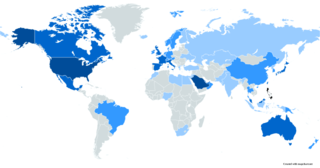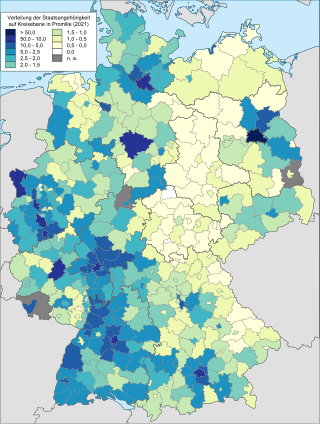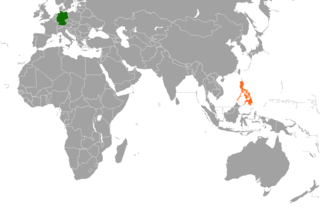Related Research Articles

A migrant worker is a person who migrates within a home country or outside it to pursue work. Migrant workers usually do not have an intention to stay permanently in the country or region in which they work.

An Overseas Filipino is a person of full or partial Filipino origin who trace their ancestry back to the Philippines but are living and working outside of the country. They get jobs in countries and they move to live in countries that they get jobs in. This term generally applies to both people of Filipino ancestry and citizens abroad. As of 2019, there were over 12 million Filipinos overseas.

Filipinos are citizens or people identified with the country of the Philippines. The majority of Filipinos today are predominantly Catholic and come from various Austronesian peoples, all typically speaking Filipino, English, or other Philippine languages. Despite formerly being subject to Spanish colonialism, only around 2-4% of Filipinos are fluent in Spanish. Currently, there are more than 185 ethnolinguistic groups in the Philippines each with its own language, identity, culture, tradition, and history.

Filipinos constitute the largest ethnic minority in Hong Kong, numbering approximately 130,000, many of whom work as foreign domestic helpers. The Eastern District has the highest concentration of Filipino residents in Hong Kong, with 3.24% of the district's population being of Filipino descent.

Overseas Filipino Worker (OFW) is a term often used to refer to Filipino migrant workers, people with Filipino citizenship who reside in another country for a limited period of employment. The number of these workers was roughly 1.77 million between April and September 2020. Of these, female workers comprised a larger portion, making up 59.6 percent, or 1.06 million. However, this number declined to 405.62 thousand between 2019 and 2020.

Spanish Filipino are an ethnic and a multilingualistic group native to the Philippines. They consist of Spaniards, Filipino mestizos, Spanish-speaking Filipinos, hispanicized Filipinos, and hispanic people from South America who are citizens of the Philippines or are descendants of the original European settlers who inter-married with native Filipinos during the Spanish colonial period. Many of their communities trace their ancestry to the early settlers from Spain and Latin America, and depending on the specific province in the Philippines, they formed as much as 19% in the capital city of Manila at formerly named Tondo province, and about 1.38% of the Ilocos region, 2.17% of Cebu or 16.72% of Bataan and other parts of the country.
Spanish people of Filipino ancestry are an ethnic and multilingualistic group in Spain, consisting of citizens and the descendants of early migrants from the Philippines to Spain, as well as more recent migrants. Some 200,000 Filipinos are estimated to live in Spain, including 37,000 expatriates from the Philippines living in Spain who are either Spanish citizens or do not hold any citizenship.
Filipino Italians are Italians who are either migrants or descendants of migrants from the Philippines. Filipinos form the fifth-largest migrant community in Italy, after the Romanian, Albanian, North African communities and Ukrainians. Italy is one of the largest European migration destination for Filipinos, the others being the UK and Spain. The Italian capital Rome and the city of Milan is home to the largest Filipino community. Roughly 108,000 documented Filipinos reside in Italy as temporary workers or permanent residents, and estimates on the number of undocumented Filipinos vary widely from 20,000 to 80,000. In 2008, ISTAT, Italy’s statistics office, reported that there were 113,686 documented Filipinos living in Italy whereas the number had been 105,675 in 2007.

The tens of thousands of Filipinos in Germany consist of people from various walks of life, including migrant workers in the medical sector and marine-based industries, as well as a number of women married to German men they met through international marriage agencies.
Filipinos in the Netherlands comprise migrants from the Philippines to the Netherlands and their descendants living there. According to Dutch government statistics, 16,719 persons of first or second-generation Philippine background lived in the Netherlands in 2011. Though Filipinos live throughout the country, Amsterdam and Rotterdam are homes to the largest Filipino communities.
Filipinos in Switzerland consist of migrants from the Philippines to Switzerland and their descendants.
Filipino women writers have played important roles within Philippine literature, with Philippine women having created enduring works of fiction and non-fiction across the genres. Writing in English, Spanish, Filipino and other local languages and native dialects, female writers from the Philippine archipelago utilized literature, in contrast with the oral tradition of the past, as the living voices of their personal experiences, thoughts, consciousness, concepts of themselves, society, politics, Philippine and world history. They employed the "power of the pen" and the printed word in order to shatter the so-called "Great Grand Silence of the Centuries" of Filipino female members, participants, and contributors to the progress and development of the Philippine Republic, and consequently the rest of the world. Filipino women authors have "put pen to paper" to present, express, and describe their own image and culture to the world, as they see themselves.

There have been several names of the Philippines in different cultures and at different times, usually in reference to specific island groups within the current archipelago. Even the name Philippines itself was originally intended to apply only to Leyte, Samar, and nearby islands. It was bestowed by the Spanish explorer Ruy López de Villalobos or one of his captains Bernardo de la Torre in 1543 in honor of the crown prince Philip, later Philip II. Mindanao, which they reached first and assumed to be the greater land, they named after the reigning emperor Charles V, who was also Spain's king Carlos I. Over the course of Spanish colonization, the name was eventually extended to cover the entire chain. It has survived with minor changes. The Philippine Revolution called its state the Philippine Republic. The US military and civilian occupations called their territory the Philippine Islands. During the Third Philippine Republic, the state's official name was formally changed to the Philippines.

The history of the Philippines from 1565 to 1898 is known as the Spanish colonial period, during which the Philippine Islands were ruled as the Captaincy General of the Philippines within the Spanish East Indies, initially under the Viceroyalty of New Spain, based in Mexico City, until the independence of the Mexican Empire from Spain in 1821. This resulted in direct Spanish control during a period of governmental instability there. The Philippines was under direct royal governance from 1821 to 1898.

José Protasio Rizal Mercado y Alonso Realonda was a Filipino nationalist, writer and polymath active at the end of the Spanish colonial period of the Philippines. He is considered a national hero of the Philippines. An ophthalmologist by profession, Rizal became a writer and a key member of the Filipino Propaganda Movement, which advocated political reforms for the colony under Spain.
Filipinos in Taiwan consist mainly of immigrants and workers from the Philippines. Filipinos form the third largest national contingent of migrant workers and account for about one-fifth of foreign workers in Taiwan as of April 2019.
Filipinos in Oman are either migrants or descendants of the Philippines living in Oman. As of 2011, there are between 40,000 and 46,000 of these Filipinos in Oman. A large destination for Overseas Filipino workers (OFWs), Oman was the only Middle Eastern nation included on the Philippine Overseas Employment Administration's list of nations safe for OFWs. The country still holds the title up to this day.

France–Philippines relations are the foreign relations between France and the Philippines. In 1947, France and the Philippines signed a Treaty of Amity which established diplomatic relations with the two countries.

Italy–Philippines relations are the interstate and bilateral relations between Italy and the Philippines. The bilateral relations between Italy and the Philippines was established on 9 July 1947.

Germany–Philippines relations are the bilateral relations of Germany and the Philippines. An agreement that was signed on April 25, 1955, led to a dynamic cooperation between the two countries. Germany has an embassy in Manila and an honorary consulate in Cebu, while the Philippines has an embassy in Berlin, a Consulate General in Frankfurt, and Honorary Consulates in Essen, Munich and Stuttgart. Germany is the top trading partner of the Philippines in the European Union after the Netherlands, France, and the United Kingdom.
References
- ↑ "Filipinos in France". September 22, 2020. Archived from the original on October 16, 2021. Retrieved May 12, 2021.
- ↑ "Les nouveaux Misérables: the lives of Filipina workers in the playground of the rich". theguardian.com. October 12, 2020. Retrieved September 14, 2021.
- ↑ "Les nouveaux Misérables: the lives of Filipina workers in the playground of the rich". theguardian.com. October 12, 2020. Retrieved September 14, 2021.
- 1 2 3 4 5 6 7 8 "Filipino Migration to Europe: Country Profiles". Europe-Philippines in the 1990s: Filipino Migration - The European Experience. CFMW. 1995. Archived from the original on August 14, 2011. Retrieved April 7, 2009.
- ↑ Fresnoza-Flot, Asuncion; Antoine Pécoud (2007). "Emergence of Entrepreneurship Among Filipino Migrants in Paris". Asian and Pacific Migration Journal. 16 (1). Scalabrini Migration Center: 1–28. doi:10.1177/011719680701600101. S2CID 143825440.
- ↑ Juan Miguel F. Zubiri (September 11, 1998). "S. No. 1549" (PDF). Retrieved November 13, 2008.
- 1 2 3 "More job opportunities await Filipinos in France". GMA News. April 10, 2008. Retrieved April 7, 2009.
- ↑ "RP freezes deployment of nurses to UAE over court case". PhilFortune. 2008. Retrieved April 9, 2009.
- 1 2 Caber, Michael (April 1, 2008). "Oui! France to accept more Filipino workers". Manila Standard Today. Retrieved April 9, 2009.
- ↑ "Immigrés selon le pays de naissance en 1999" [Immigrants by country of birth in 1999](XLS) (in French). INED. 2000. Retrieved April 9, 2009.[ permanent dead link ]
- ↑ "Filipino language schools France". language-programs.net. 2008. Archived from the original on July 23, 2011. Retrieved April 9, 2009.
- ↑ "Pista sa Paris 2008". Republish of the Philippines Department of Foreign Affairs (Press release). August 7, 2008. Archived from the original on December 10, 2008. Retrieved April 9, 2009.

